An OLED, that is, an Organic Light-Emitting Diode, is also called an Organic Electroluminescence Display (OELD). OLED is considered to be the next generation of the most promising new flat display technology due to its softness, transparency, clear picture quality, energy saving and environmental protection. Therefore, since 2003, this display device has been widely used in MP3 players. For DCs and mobile phones that are also digital products, the engineering samples using OLED screens have only been shown at some exhibitions, and they have not yet entered the stage of practical application. But OLED screens have many advantages that LCDs can't match.
Unlike traditional LCD displays, OLED display technology eliminates the need for backlights and uses very thin organic coatings and glass substrates that illuminate when current is passed through. Moreover, the OLED display screen can be made lighter and thinner, has a larger viewing angle, and can significantly save power.
At present, in the two major technical systems of OLED, the low-molecular OLED technology is mastered in Japan, and the so-called OEL of the polymer PLEDLG mobile phone is this system. The technology and patents are mastered by the British technology company CDT, compared with the PLED products. There are still difficulties in colorization. Low-molecular OLEDs are easier to colorize, and Samsung recently released 65,530-color OLEDs for mobile phones.
However, although OLEDs with better technology will replace LCDs such as TFTs in the future, organic light-emitting display technologies have shortcomings such as short lifetime and large screen size. The OLED is constructed such that each OLED unit can be imagewise compared to a hamburger, the luminescent material is the vegetables sandwiched in the middle, and the display unit of each OLED can controlly generate three different colors of light. Like LCDs, OLEDs are also active and passive. In the passive mode, the cell selected by the row and column address is illuminated; in the active mode, there is a thin film transistor (TFT) behind the OLED unit, and the light emitting unit is lit under the TFT driving. In the current situation, passive OLEDs are more energy efficient, but active OLEDs display better performance.

3D curved full coverage Samsung Tempered Glass is easy to fit with your phone. And full coverage AB glue Samsung Screen protector don't splash when it cracked. HD clear smooth as silk and comfortable touch feeling can provide you original experience. 9H scratch resistant can protect your phone from being scratched by hard objects. Nano waterproof Oleophobic coating can magically resist dirt, sweat and annoying fingerprints.
For Model No: Samsung Galaxy S9 Plus, Samsung Galaxy S9, Samsung Galaxy S8 Plus, Samsung Galaxy S8, Samsung Galaxy Note 8, etc.

Pls feel free to contact us if you are interested in these products, have any questions or special needed. We have the best sales team to service to you.
Look forward to your inquiry, and welcome to visit our factory.
Samsung Tempered Glass
Samsung Tempered Glass,Anti Blue Light Tempered Glass For Samsung,Samsung Tempered Glass Screen Protector,Hd Tempered Glass For Samsung
Shenzhen Kantou IM Technology Co., Ltd. , http://www.kantou-im.com
